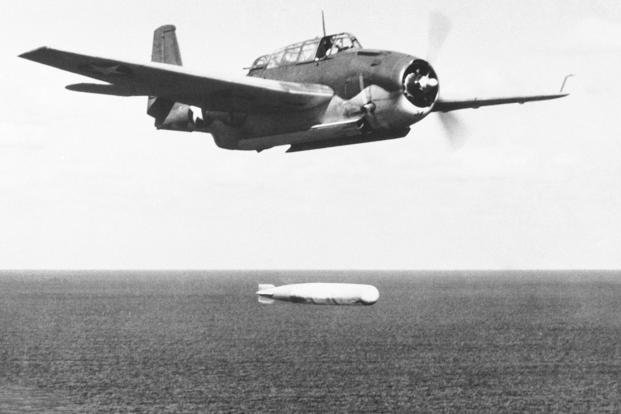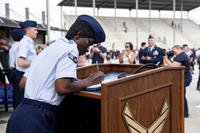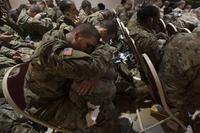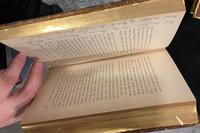This article was sponsored by General Motors.
A total of 343,000 automobiles left the General Motor's super-assembly plant in Linden, New Jersey, between 1937 and 1941. Throughout these years of peace, Buicks, Pontiacs and Oldsmobiles flowed in an endless procession from this factory into dealers' showrooms from Maine to Virginia -- then production stopped.
The United States government was gearing up for war. A "slowdown" order had been issued to GM and other auto companies as federal agencies started to assess what the nation might need in the event it was drawn into the wars that raged in Europe and the Pacific. As a result, companies were scrambling to stay alive and adjust to the rapidly changing economic climate and world order.
The general manager of GM's Linden Division appeared in Detroit prior to the Linden shutdown. He and his staff had worked frantically to avoid the action and to keep his 4,000 employees on the job. The recommendation made up the chain was that the Linden plant try to work as a subcontractor that made aircraft wings. With metalworking experience, the plant layout and GM's know-how, the suggestion seemed logical.
Linden officials reached out to most of the aircraft producers across the country. Would they be interested in having a division of GM make wings for them? Each gave the same answer -- not interested. Various government agencies replied the same way.
But the search continued despite the discouragement. GM officials got wind of a new Army fighter, the P-47 "Thunderbolt," which was still a deep secret. A representative was dispatched to Washington, D.C., armed with floor plans and stats.
Somehow along the way, the GM rep found himself in company with the Navy instead of the Army. The Navy officers studied the material he had brought to close the deal on the P-47. It turned out that the rep's timing was perfect in that the Navy was also about to go all-out on a new warplane -- a torpedo bomber, not a fighter. And as they considered it, they figured they would need a factory just about the size of the Linden automobile plant.
But the GM rep was still bullish on the notion that the Army would see its way to awarding GM the contract for the P-47, so he stayed in Washington a few more days waiting for something to happen. The rep was so sure of the Army's intent that he called his manager and told him to get down to D.C. as soon as possible.
The Linden manager called GM headquarters in Detroit to let them know he was going to Washington to work on the P-47 deal, and in response, the Detroit execs told him to meet with the Navy instead.
To the GM group that met in Washington the following day, the name "Grumman" was an unknown quantity. They had not heard of the firm, which had been established in an abandoned garage on Long Island, New York, 13 years before. Grumman had orders flooding in as the drums of war beat ever louder, and the company was having trouble expanding to meet the demand.
At the meeting with the Navy officials, the GM team was surprised to learn that the Navy wanted the company to do more than just make wings. The sea service needed GM to assist Grumman in making entire airplanes.
The companies signed a mutual agreement and started to figure out the details of how they might work together to meet the Navy's torpedo bomber needs. To the Grumman officials, the GM auto assembly plant was a huge place comprising four walls jammed with equipment, fixtures and machinery, which were entirely useless to aircraft manufacture.
Auto production was still being cleaned up. Overhead and underfoot was a type of gear representing the highest refinement of specialized mass production technique -- a plant designed to eject one finished automobile every 60 seconds.
The Grumman plant, on the other hand, presented an entirely different aspect to the GM reps who were accustomed to GM's sense of flow. The GM team saw at Grumman a great deal of activity but an apparent dispersal of effort. Grumman's tools and methods of manufacture seemed primitive to the GM team, while the Grumman team felt that GM's process was too over-specialized and could never work in the airplane business.
As the companies tried to figure out how to make their partnership work, the Navy dropped another bombshell: It announced -- out of the blue -- that it wanted GM to take on another Grumman plane -- a plane that had won laurels for its heroic work with the Marine Corps in defending Wake Island. The plane was the legendary F4F "Wildcat."
The GM team was in no way prepared for this surprise. "It practically floored me," one rep later related, "because I didn't know how we were going to make the first plane."
So the GM team left Washington for Detroit with two planes in their hats, and no facilities with which to build them -- beyond the doubtful adaptability of the Linden assembly plant, which obviously was too small for a staggering program. What was needed was a full-fledged division setup, complete with engineering, manufacturing and assembly facilities.
So General Motors set out on a strategy to organize a new division that would draw from other divisions' pool of experience while creating a completely new manufacturing process -- as though GM was starting a new company.
And on Jan. 21, 1942, Eastern Aircraft was born.
The following day, thousands of GM employees found out they now worked for Eastern Aircraft by reading the newspaper. The press notice was brief and basically identified which GM plants would be taken over by the new division -- five East Coast plants: the Linden Division assembly plant in Linden, N.J.; the Delco-Remy Battery plant in Bloomfield, N.J.; the Trenton-Ternstedt hardware plant in Trenton, N.J.; and the Fisher Body plants in Tarrytown, N.Y., and Baltimore.
This effort ultimately yielded 7,860 Wildcats and 9,839 Avengers that allowed the U.S. Navy and Marine Corps to dominate the skies over the Pacific during World War II.
Read more about GM's extensive role in military history.
Find the Right Veteran Job
Whether you want to polish your resume, find veteran job fairs in your area or connect with employers looking to hire veterans, Military.com can help. Subscribe to Military.com to have job postings, guides and advice, and more delivered directly to your inbox.











